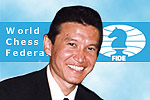| 16. |
Tie-break Rules
Specific tie-break rules are given in regulations of most FIDE
competitions. In the absence of such regulations, precedence shall be determined
by the following:
-
For swiss tournaments where the players involved have all
played only against rated opponents, after eliminating the lowest rated
opponent, find the sum of opponents' ratings. The highest total wins. If still
tied, eliminate the rating of the next lowest rated opponent(s) until a decision
is possible.
-
For other Swiss tournaments, the sum of progressive scores. The
highest total wins. If still tied, deduct the first round score, and if
necessary the second round and so on. |
| 17. |
Late entries
According to FIDE Tournament Rules, any prospective participant
who has not arrived at the venue of a FIDE competition before the scheduled time
for the drawing of lots shall be excluded from the tournament. An exception may
be made in the case of a registered participant who has given written notice in
advance that he will be unavoidably late. Where the Chief Arbiter decides to
admit a Late Entrant,
-
if the player's notified time of arrival is in time for the
start of the first round, the player is given a pairing number and paired in the
usual way.
-
if the player's notified time of arrival is in time only for
the start of the second (or third) round, then the player is not paired for the
rounds which he cannot play. Instead, he receives no points for unplayed rounds,
and is given an appropriate pairing number and paired only when he actually
arrives. In these circumstances, the Pairing Numbers that were given at the
start of the tournament are considered provisional. The definitive Pairing
Numbers are given only when the List of Participants is closed, and corrections
made accordingly in the results charts. A player who is not present cannot
receive the Bye. |
| 18. |
Maximising players' opportunities
The FIDE Swiss Rules pair the players in an objective and
impartial way, and different arbiters following the pairing rules should arrive
at identical pairings. A proposal for varying the normal pairing so as to
maximise players' opportunities to fulfil title requirements was not approved in
the Graz Congress. |
| 19. |
As directed by the Kishinev Congress 1997, below is the list of
endorsed programmes and their respective capabilities:
- PETUNIA Dutch System
- GMB Lim System
- SWISS CHESS Dutch System
- SVBOSS Dutch System
- DUBOV
- BURSTEIN System (GA '98)
|
| 20. |
Mandatory information to be provided in tournament's reports
by arbiters |
|
20.1 |
While reporting a tournament to FIDE, the Arbiter shall declare
which of the official FIDE Swiss Systems was used. (GA '97). |
|
20.2 |
If another system was used, the Arbiter has to submit the rules
of this system for checking by the Swiss Pairing Committee (GA '97)
|
|
20.3 |
Where it can be shown that modifications of the original
pairings were made in favour of a player to achieve a norm, a report may be
submitted to the Qualification Commissionto initiate disciplinary measures
through the Ethics Commission (GA '97) |
| 21. |
Amendments to the existing Swiss Sytem Rules (Dutch
System)
The rules B2, B5 and B6 shall not apply in the last round at
scoregroups with a score over 50 % if this helps to produce a greater number of
pairings in the scoregroup. If the number of pairings would be the same when
these rules are used, they shall be used. |
| 22. |
Pairings for members of the same federation
Members of the same federation in a scoregroup of over 50 %
will be not be paired against each other in the last three rounds of a Swiss
tournament in Youth and Junior Championships (EB '99) |


